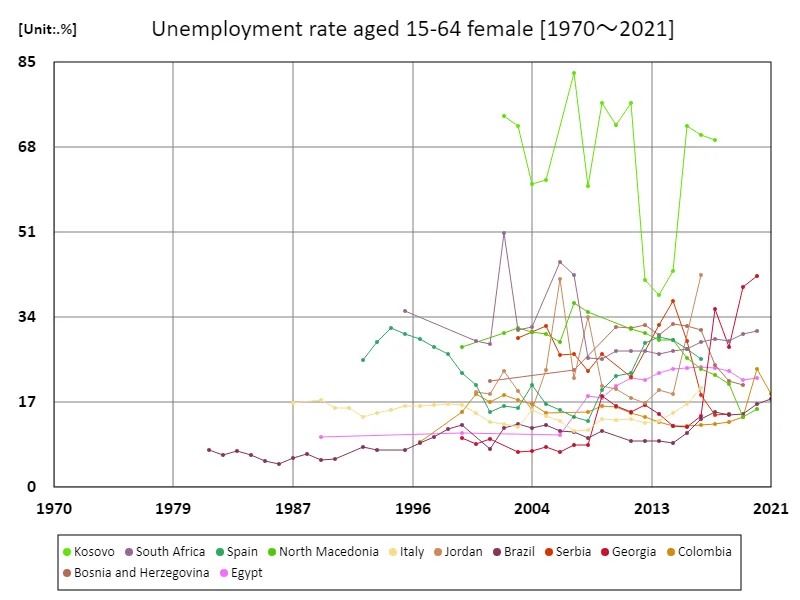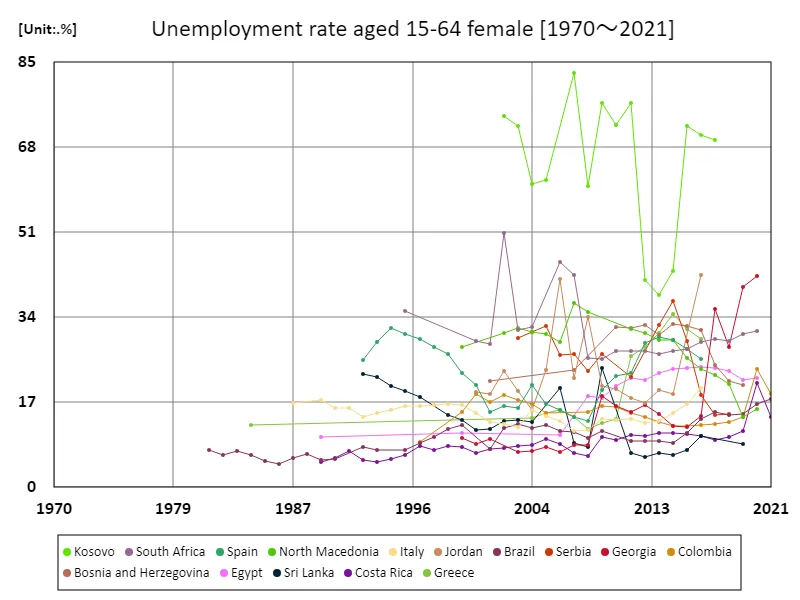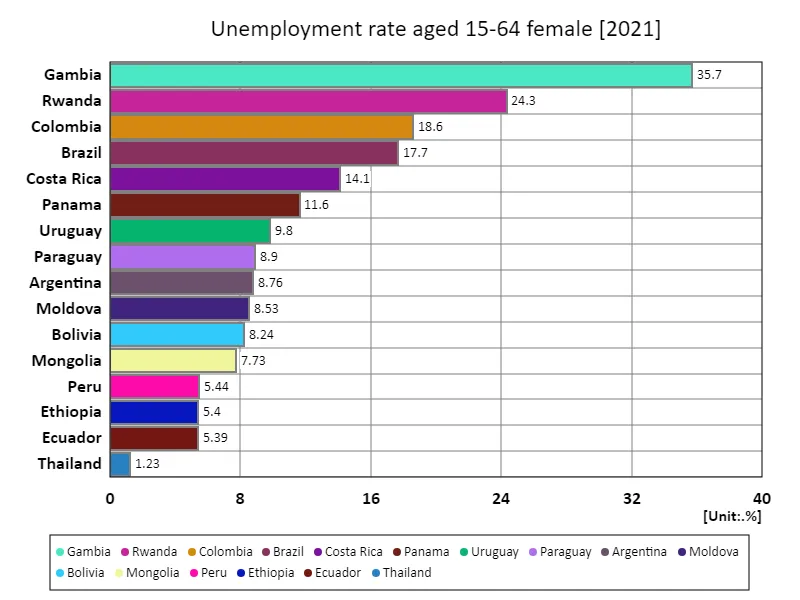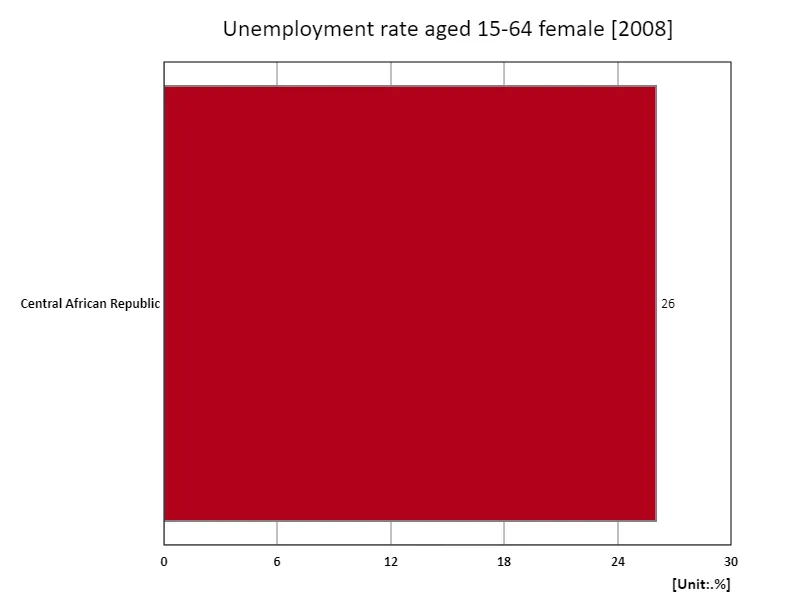- Abstract
- Unemployment rate for women aged 15-64 (percentage of total female labor force)
- Unemployment rate for women aged 15-64 (percentage of total female labor force) (worldwide)
- Unemployment rate for women aged 15-64 (as a percentage of total female labour force) (worldwide, latest year)
- Unemployment rate for women aged 15-64 (percentage of total female labour force) (region, latest year)
- Reference
Abstract
Female unemployment rates vary widely across countries, with Colombia’s particularly high figure of 18.6 percent reflecting several factors. In Colombia, economic instability and unequal educational opportunities make it difficult for young and low-skilled women in particular to find employment. Also contributing is the slow economic recovery following the pandemic, limiting access to the job market. In contrast, female labor force participation rates are on the rise in developed countries, creating a need for policies and support. Overall, women’s employment status is heavily influenced by socio-economic factors, and policy review and support are essential for sustainable future growth.
Unemployment rate for women aged 15-64 (percentage of total female labor force)
Kosovo’s female unemployment rate has shown notable fluctuations between 1981 and 2021. In particular, the astonishing figure of 82.9% in 2007 reflects the difficulties of postwar economic reconstruction and social constraints. This high unemployment rate is due to a lack of education and vocational training, and a weak industrial base. The current figure of 83.9% in 2021 suggests a still tough labour market, with persistent barriers faced by women in particular. Although international support and policy improvements are needed, the reality is that many women remain excluded from the labour market. Compared to other countries, Kosovo is in a unique situation and urgently needs a long-term strategy to increase women’s economic participation. Reducing the unemployment rate requires expanding educational opportunities and creating jobs, which will lead to sustainable growth in the future.


The maximum is 82.9%[2007] of Kosovo, and the current value is about 83.9%
Unemployment rate for women aged 15-64 (percentage of total female labor force) (worldwide)
Kosovo’s female unemployment rate shows a notable trend between 1981 and 2021. In particular, the extreme figure of 82.9% recorded in 2007 reflects the severe impact of war and economic instability. During this time, a combination of social barriers, lack of education and limited access to the labour market meant many women were unable to find work. The high unemployment rate of 83.9% in 2021 remains alarming and means that women’s economic participation is severely limited. Compared to other countries, Kosovo’s female unemployment rate is unusually high, making economic reconstruction and policy improvements urgently necessary. It is necessary to improve education and vocational training and to implement measures to support businesses, and creating employment opportunities for women is particularly important. A strategic approach is needed to reduce barriers to labour market entry and promote sustainable economic growth through international assistance and cooperation. Improving the economic participation of Kosovo’s women will contribute to regional stability and prosperity.


The maximum is 82.9%[2007] of Kosovo, and the current value is about 83.9%
Unemployment rate for women aged 15-64 (as a percentage of total female labour force) (worldwide, latest year)
According to 2021 data, Gambia’s female unemployment rate is very high at 35.7%, reflecting challenges in female labour force participation rates in many countries. With an overall average unemployment rate of 12%, The Gambia is in a unique situation. This high unemployment rate is due to economic instability, lack of educational opportunities, and lack of job creation, especially for women. Furthermore, the total unemployment rate of 191% indicates a high proportion of unemployed women in the overall female workforce. This clearly limits opportunities for women to become economically independent. Although there has been a lot of emphasis on female labor participation over the past few decades, this has not translated into real improvements. There is an urgent need to strengthen policy support and educational programs, and vocational training and entrepreneurial support for women in particular are thought to be effective. By addressing these issues in the future, we can expect to see improved economic status for women and sustainable growth.


The maximum is 35.7% of Gambia, the average is 12%, and the total is 191%
Unemployment rate for women aged 15-64 (percentage of total female labour force) (region, latest year)
According to 2008 data, the female unemployment rate in the Central African Republic was 26 percent, in line with the national average at that time. This high unemployment rate reflects the country’s economic instability and political turmoil, and reflects a lack of employment opportunities, especially for women. Although women make up a significant portion of the economy’s workforce, social barriers and lack of educational opportunities remain major obstacles to gaining employment. During this time, unemployment rates for women tended to be high worldwide, particularly in developing countries. In many countries, women have limited access to education and lack support when entering the labour market. Limited career options are also a contributing factor in female unemployment. Policy initiatives are essential to improve this situation. There is a need to expand educational opportunities, strengthen vocational training programs, and support women in starting their own businesses. This is expected to increase women’s participation in the economy and contribute to sustainable growth.


The maximum is 26% of Central African Republic, the average is 26%, and the total is 26%



Comments